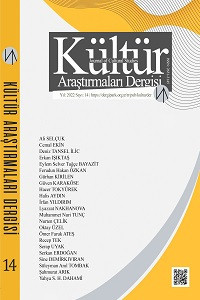Göçebe ve Dış Dünya
Anatoly M. Khazanov tarafından kaleme alınan eser, Avrupa merkezli tarih yazım geleneğini yansıtan ve göçebe bozkır toplumlarını uygarlık ve ilerlemenin önündeki en büyük düşman olarak telakki eden söyleme, bir karşı tez niteliğindedir. Yazar, göçebe toplumların gelişim evrelerini ve sosyal temellerini, iktisadî faaliyetleri çerçevesinde açıklama yoluna giderken, aynı konuyu ele alan tarihçilerin yetersiz kaynak kullanımını da eleştirmektedir. Khazanov’a göre, konuyu araştırmak için antropoloji biliminden yararlanmak elzemdir. Ancak bu sayede göçebelik ve göçebe devletler konusu anlaşılabilir. Zira Khazanov çalışmasında, bu kavramların da yeniden gözden geçirilmesi gerektiğine vurgu yapmakla birlikte, sanıldığının aksine, çoğu tarihçinin “göçebe devletler” adı altında araştırdıkları devletlerin çoğunun yarı göçebe, hatta yerleşik devletler olduğunu iddia etmektedir. Yazar, yine bilinenin aksine, göçebe istilalarının, tek taraflı bir yıkım hareketi olmayıp, yerleşik dünya ile simbiyoz ilişkiye (ortak fayda) ve dış dünya ile uyum sürecine işaret eden bir olgu olduğunu ispat etme gayretindedir. Eser daha çok Avrasya bozkırları ve göçebe toplumları üzerine yoğunlaşmakla birlikte, toplumsal yapıyı ve tarihsel süreci Türkler ve Moğollar üzerinden ele almaktadır. Önsöz, giriş ve beş bölümden oluşan kitap, Khazanov’un, Bolşevik baskısı nedeniyle Moskova’dayken yazamadığı; ancak Amerika Birleşik Devletleri’ne göç ettikten sonra ilave ettiği ikinci giriş kısmından oluşmaktadır.
Nomads and the Outside World
The work written by Anatoly M. Khazanov is a counter-thesis to the discourse that reflects the European-centered historiography tradition and does not consider nomadic steppe societies as the biggest enemy of the continuation of civilization and progress. While the author goes on to explain the development stages and social foundations and economic processes of nomadic societies, he also criticizes the insufficient source information of historians who deal with the same issue. According to Khazanov, it is essential to use the science of anthropology to research the subject. Only in this way is the method of the subject of nomadism and nomadic states. In his work, Khazanov, although making a comprehensive emphasis on the revision of these concepts, claims that, contrary to popular belief, most of the states that history studies under the name of "nomadic states” are semi-nomadic or even disabled states. The author strives to prove that, contrary to popular belief, nomadic invasions are not a one-sided act of destruction, but rather a phenomenon that shows symbiosis with the world and gives signs of harmony with the outside world. Although the work focuses mostly on the Eurasian steppes and nomadic societies, the social structure and events are discussed through Turks and Mongols. The book, which includes a foreword, introduction and five chapters, was written by Khazanov because he could not write it while in Moscow due to Bolshevik pressure; However, it consists of a second introduction that he added to the original copy after his immigration to the United States paintings.
___
- Allsen, Thomas (1995). “Review of Nomads and the Outside World”. The International History Review, 17(3): 563-565.
- Khazanov, Anatoly Mihailovich (2015). Göçebe ve Dış Dünya. Çev. Ömer Suveren. İstanbul: Doğu Kütüphanesi.
- ISSN: 2651-3145
- Yayın Aralığı: Yılda 4 Sayı
- Başlangıç: 2018
- Yayıncı: Mehmet Ali YOLCU
Sayıdaki Diğer Makaleler
Evrensel Sergi Anlayışı ve Mimariye Etkileri
Bile Bile Yapamıyorum: Y Kuşağı Nasıl Tükenmiş Kuşak Oldu?
Coğrafi İşaretleri Açısından Balıkesir İli Üzerine Bir Değerlendirme
Milli Stratejiler İçinde Halkçı Taktikler: Alevi Topluluklarda Folklorik Millilik
Bir Risalede Halk Hekimliği ve Halk İnançlarına Dair Unsurlar
Wells’in Dünyalar Savaşı Romanında Apokaliptik Özelliklerin İncelenmesi
Türkiye'de Yazılan Maddi Kültür Başlıklı Lisansüstü Tezlerin İncelenmesi
Homi Bahbha'nın "Kültürel Çeviri" Kavramına Çeviribilimsel Bakış
Dinin Postmodern Hâli: Elif Şafak'ın Roman Kahramanları Dolayımında Sosyolojik Bir Analiz
